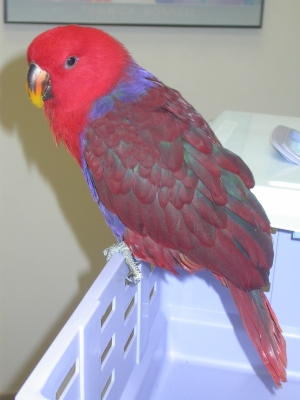
This April gave us an eclectic mix of weather, so it seems appropriate that our Animal of the Month for April is also eclectic. But now that the last day of April is upon us, it’s time to say goodbye to the eclectus parrot as our featured creature. We hope you were following us @ExoticPetVets on Twitter and enjoyed our tweets about these colourful characters. If you missed any, here is a summary. Did you know?:
- Eclectus parrots (Eclectus roratus) are native to the rainforests in parts of Indonesia, Australia, the Solomon Islands and Papua New Guinea. They were also introduced to Palau.
- In the wild, eclectus parrots are found high in the tree canopy where they perch and feed on fruit, flowers, nectar, nuts and seeds.
- Eclectus parrots are large-sized parrots with short square tails. They are, on average, about 35 cms (14 inches) in length.
- The eclectus parrot’s contour feathers (which are feathers that outline a bird’s plumage) are noticeably different compared to other parrot species both in structure and appearance.
- The contour feathers of eclectus parrots don’t have interlocking barbs (which are the small strands that branch out from the feather shaft) as seen in other parrot species. This gives eclectus parrot feathers a hair-like appearance.
- It’s not hard to tell if an eclectus parrot is a girl or boy. The eclectus parrot is very sexually dimorphic, meaning the males and females are extremely different in physical appearance.
- Male and female eclectus parrots look so different from each other, it was once believed that they were two separate species. The “eclectus” part of their name is derived from the word “eclectic” because of the variety of colours between the genders.
- Male eclectus parrots are bright green with blue feathers in the bend of the wing and red feathers in the underwing. Their upper beaks are orange and become yellow towards the tip. Males also have reddish-orange irises in their eyes.
- Female eclectus parrots are scarlet red with a darker red back and tail and a midsection that is a blueish-purple hue. They have black beaks and their irises are light yellow.
- When female eclectus parrots reach breeding age, they tend to be bossier, moodier and more territorial than their male counterparts.
- Female eclectus parrots are polyandrous, meaning they will mate with several different males. In the wild, they will build their nests up to six metres deep in the tall tree trunks.
- The nesting instincts of female eclectus parrots are so strong that even in captivity, they will try to find nesting sites within a home – even if they are kept alone.
- Observations in the wild show both eclectus parrot parents – and up to eight other birds of both genders – will help care for eclectus chicks.
- Eclectus parrots are very sensitive to what they eat because their digestive tract is longer than most other parrot species.
- Things like preservatives, fortified foods, additives and calcium deficiency – among other dietary problems – can cause eclectus parrots to develop behaviours known as toe-tapping and wing-flipping.
- Toe-tapping is when eclectus parrots open and close their toes while wing-flipping is when they slightly move or flick their wings. Both movements are involuntary.
- Eclectus parrots are generally calm and easy-going birds. In captivity, they are content to quietly play with their bird-safe toys for hours.
- Eclectus parrots are generally not demanding birds in captivity. But they don’t like commotion or sudden change. They enjoy a stable daily routine in a quiet home.
- Ecelectus parrots are often misunderstood. Their behaviour has been labelled as boring and dull. But if they are being lethargic, it is their way of responding to stressful situations.
- In general, eclectus parrots are relatively quiet birds and are not prone to screaming. But their calls are shrill and can be very loud.
- Eclectus parrots have a couple of different calls. They can call loudly when they are excited or trying to communicate with a family member. Their other call is more toned-down and is used while feeding.
- Eclectus parrots are very intelligent birds and have an excellent ability to mimic human speech and laughter along with sounds such as sneezing and the beeping of a microwave.
- The average lifespan of an eclectus parrot in captivity is unclear as it wasn’t until the 1980’s that these birds became more popular as pets in North America.
- Even when eclectus parrots became popular birds to keep in captivity in the 1980’s, their nutritional requirements were a bit of a mystery to most people so many birds didn’t get what they needed to maintain good health.
- It’s been noted that eclectus parrots in captivity can live between 30 and 40 years, but it’s believed they can live much longer than that (50-75 years) with good care and proper nutrition.

